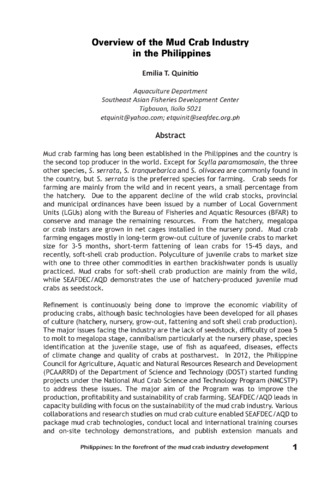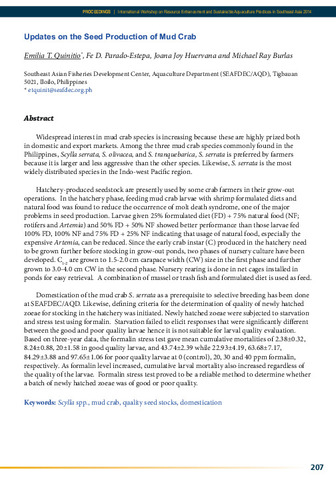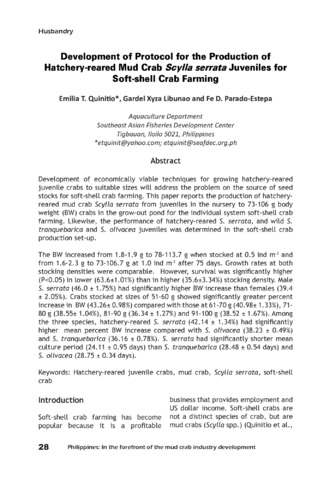Seed production of mud crab Scylla serrata juveniles
Share
| dc.contributor.author | Quinitio, Emilia T. | |
| dc.contributor.author | Parado-Estepa, F. D. | |
| dc.contributor.author | Millamena, Oseni M. | |
| dc.contributor.author | Rodriguez, E. | |
| dc.contributor.author | Borlongan, Emeterio | |
| dc.date.accessioned | 2014-01-16T09:07:56Z | |
| dc.date.available | 2014-01-16T09:07:56Z | |
| dc.date.issued | 2001 | |
| dc.identifier.citation | Quinitio, E. T., Parado-Estepa, F. D., Millamena, O. M., Rodriguez, E., & Borlongan, E. (2001). Seed production of mud crab Scylla serrata juveniles. Asian Fisheries Science, 14(2), 161-174. | en |
| dc.identifier.issn | 0116-6514 | |
| dc.identifier.uri | http://hdl.handle.net/10862/1910 | |
| dc.description.abstract | A protocol for the large-scale rearing of the mud crab Scylla serrata juveniles was developed based on the results of small-scale experiments on feeding and water management. This paper also reports the success in producing the second generation (F2) crabs. Pond-reared adult S. serrata held in 10 m3 concrete tanks with sand substrates were given fish, mussel, annelids and formulated diet. The zoeae produced were stocked in 1.5 or 10 m3 tanks at 30 to 50 ind-l-1 and fed 10 to 15 Brachionus rotundiformis ml-1, 1 to 5 Artemia sauna nauplii ml-1 and 1.5 to 2.0 g shrimp larval commercial diet-m-3 day. Water was replaced daily at 30 to 50% of the total volume starting day 3. Megalops were nursed until crab stage either in tanks or in net cages installed in ponds. Crabs were fed mussel or small shrimps (Acetes sp). Hatching occurred 6 to 12 days after spawning at 26.5 to 30.5°C. A female produced 0.42 to 5.23 x 106 zoeae at a time. Mean survival rate from zoea 1 to 3- to 5-day old megalopa was 2.6 ± 0.8% and 32.8 ± 4.8% from megalopa to crab stage. The development from zoea 1 to megalopa required 16 to 18 days. Cannibalism and luminescent bacteria were identified as the major causes of mortality. Highest mortality was observed during the metamorphosis from zoea 5 to megalopa and megalopa to crab 1. First crab stage was obtained 23 to 25 days after hatching. Sorting the crabs during the nursery period minimized cannibalism. Completion of the cycle in captivity was attained in 1997 and 1999 when spawns from pond-reared crabs grew to become the second-generation broodstock. The results point to a minimum age of 7.5 to 9 months at which S. serrata hatched their eggs after rearing from zoea 1. | en |
| dc.description.sponsorship | The authors thank the Australian Centre for International Agricultural Research for providing partial funding for this project (PN 9217). | en |
| dc.language.iso | en | en |
| dc.publisher | Asian Fisheries Society | en |
| dc.subject | Scylla serrata | en |
| dc.title | Seed production of mud crab Scylla serrata juveniles | en |
| dc.type | Article | en |
| dc.citation.volume | 14 | |
| dc.citation.issue | 2 | |
| dc.citation.spage | 161 | |
| dc.citation.epage | 174 | |
| dc.citation.journalTitle | Asian Fisheries Science | en |
| dc.subject.asfa | cannibalism | en |
| dc.subject.asfa | crab culture | en |
| dc.subject.asfa | crustacean larvae | en |
| dc.subject.asfa | Megalops | en |
| dc.subject.asfa | pond culture | en |
| dc.subject.asfa | rearing techniques | en |
| dc.subject.asfa | seed production | en |
| dc.subject.asfa | seeding (aquaculture) | en |
| dc.subject.asfa | survival | en |
| dc.subject.asfa | zoeae | en |
| dc.subject.scientificName | Scylla serrata | en |
Files in this item
| Files | ขนาด | รูป | View |
|---|
รายการนี้ปรากฏใน (s)
-
AQD Journal Articles [1240]
These papers were contributed by AQD staff to various national and international journals



